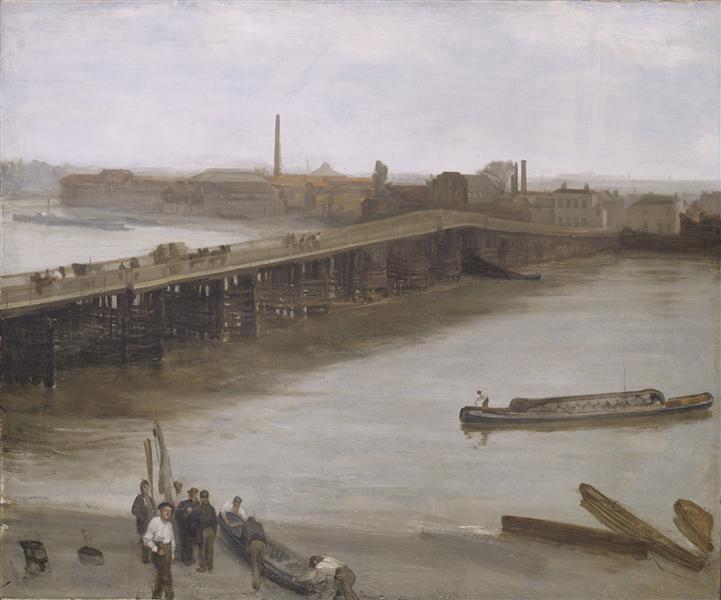Description
The paint "Brown and silver: Old Battersa Bridge - 1859" by James McNeill Whistler, encapsulates an almost dreamlike atmosphere, enhanced by the subtle and delicate color palette that the artist uses. This work is a tangible testimony of Whistler's ability to capture the essence of a place through a technique that deviates from the traditional precepts of landscape painting and embraces a more tonal and atmospheric approach.
James McNeill Whistler, a pioneer of modern art and a central figure in the evolution of the art of the nineteenth century, was known by his style that merged elements of the realistic school with an incipient symbolism, which would later develop as one of the distinctive characteristics of modernism. In "Brown and Silver: Old Battersa Bridge", Whistler shows his interest in the effects of light and color on the structure and urban landscape.
The composition of the work is particularly harmonious. In the center, the old battersa bridge rises with an almost ghostly presence, wrapped in mists that mitigate their contours. The bridge, although clearly demarcated, gradually fades in the nebulous background, a reflection of Whistler's subtle technique in the use of brown and silver to create an ethereal atmosphere. This approach not only highlights the structure of the bridge, but evokes an emotional connection with the viewer, inviting it to an introspective contemplation.
The controlled and measured use of color is a distinctive characteristic of Whistler's work. In this painting, brown and silver tones dominate the scene, creating a feeling of serenity and melancholy. The colors are gently merged, without hard edges, which suggests a continuity between the different elements of the landscape, a technique that Whistler dominated and that would be fundamental for his subsequent association with the symbolist movement.
In the work, the river under the bridge is represented with a lyrical treatment, reflecting the gray light of the sky and the surrounding structures. This body of water acts almost like a mirror, doubling the feeling of infinity and vastness. The slight ridges and undulations on the surface of the water are hinted at soft brushstrokes, which contrasts with the most defined structure of the bridge.
There are no visible human figures in brown and silver: ancient battersa bridge, which can be interpreted as a deliberate intention of the artist so that the viewer focuses on the interaction between the natural and architectural elements and the atmosphere that envelops them. This human emptiness allows a more universal reading of the work, where interpretation and emotion are at the mercy of whoever observes it.
In the context of Whistler's career, this painting aligns with other works in which the artist explored the poetics of urban landscapes and the effects of fog and light. Works such as "Nocturne in Black and Gold The Falling Rocket" or "Night: Blue and Gold Old Battersa Bridge" show a consistency in the thematic and technical exploration that Whistler maintained throughout his life.
In summary, "Brown and Silver: Old Battersa Bridge - 1859" is not only an exquisite example of James McNeill Whistler's technical ability, but also a work that evokes an atmosphere of quiet contemplation. Through its master control of color and composition, Whistler manages to convert a simple urban landscape into a poetic meditation on light, atmosphere and structure.
KUADROS ©, a famous paint on your wall.
Hand-made oil painting reproductions, with the quality of professional artists and the distinctive seal of KUADROS ©.
Art reproduction service with satisfaction guarantee. If you are not completely satisfied with the replica of your painting, we refund your money 100%.

